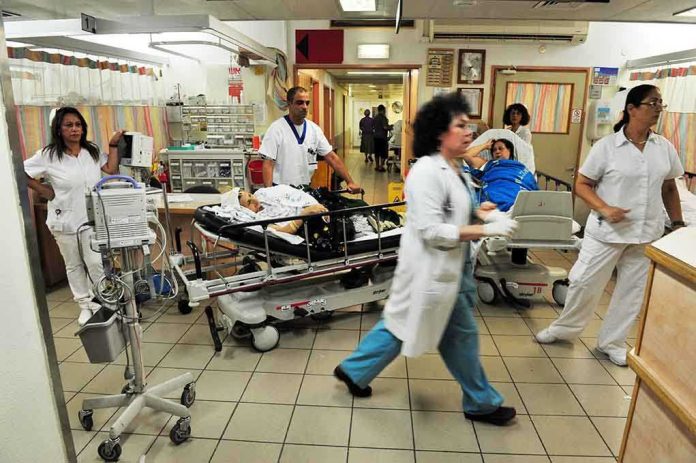
A Massachusetts woman’s summer vacation turned into a financial nightmare after a wild bat flew directly into her mouth, leaving her with a shocking $21,000 medical bill for rabies treatment.
Story Snapshot
- Erica Kahn, a Massachusetts resident, faced a rare and alarming wildlife encounter while vacationing in Northern Vermont
- Preventive rabies treatment resulted in medical bills totaling nearly $21,000
- The story highlights the crushing cost of emergency healthcare and insurance gaps in the United States
- This incident is fueling renewed debate about the accessibility and affordability of critical medical care
Vacation Turned Costly: Bat Encounter Leads to Five-Figure Bill
Erica Kahn was enjoying her time in Northern Vermont when an event no one could have predicted occurred—a wild bat, swooping out of the night, flew straight into her open mouth. With rabies considered nearly always fatal once symptoms appear, the local hospital advised immediate post-exposure prophylaxis, a multi-step series of powerful shots and immunoglobulin infusions meant to block the virus before it took hold. Despite the urgency and necessity of these treatments, Kahn soon discovered that such life-saving intervention comes at a steep price: her bills from the episode soared to nearly $21,000, a sum that left her and her family reeling and searching for answers about how such costs are even possible in America’s healthcare system.
Rabies, while rare thanks to modern vaccination protocols, remains a deadly threat in North America, especially from bats. Medical experts stress there is no alternative to immediate and aggressive treatment after exposure, regardless of cost. In Kahn’s case, doctors took no chances: she received the full regime of rabies post-exposure prophylaxis, which meant multiple ER visits, injections, and lab tests. Insurance, as is too often the case, covered only a portion of these expenses, forcing her to shoulder most of the burden herself. The ordeal not only upended her vacation, but also left her with crippling financial stress and questions about what ordinary Americans are supposed to do when emergencies strike.
The Reality of Emergency Healthcare Costs in the U.S.
Kahn’s experience is far from unique. Across the country, patients facing rare but urgent medical situations—especially those requiring expensive biologics or multiple ER visits—often find out too late that insurance coverage is patchy and unpredictable. Rabies post-exposure prophylaxis, in particular, is notorious for its cost, sometimes exceeding $10,000 to $20,000 even for patients who follow all the rules and have insurance. Hospitals and insurers frequently blame each other for these sky-high bills: hospitals point to the price of the medication and the need for immediate, around-the-clock care, while insurance companies cite policy exclusions or high deductibles. In the end, it’s families like the Kahns who pay the price.
Advocates for healthcare reform argue that stories like this should not happen in the United States. They point to the need for stronger consumer protections, real price transparency, and policies that ensure no American is financially ruined by a freak accident or wildlife encounter. While many on the left tout government-run solutions, conservatives note that the real problem is a lack of freedom and competition in the healthcare market, not too little government involvement. The fundamental question remains: in the world’s most advanced economy, why are Americans still hit with bills that would bankrupt most working families?
Insurance Gaps, Systemic Flaws, and Calls for Reform
Experts in healthcare policy cite rabies prophylaxis as a prime example of the broader crisis of U.S. medical affordability. The drug itself is expensive, but the administrative and hospital fees layered on top can make the final bill staggering. Insurance companies often categorize such incidents as “out-of-network” or “emergency exceptions,” leaving patients with little recourse. Kahn’s case has drawn intense media scrutiny, with sympathetic coverage highlighting her ordeal and the broader issue of patients caught in the crossfire between hospital billing departments and insurance adjusters.
Public health officials are unanimous on one point: immediate rabies treatment is essential and non-negotiable, as delays are a death sentence. But the fact that such a necessary intervention can leave Americans on the hook for tens of thousands of dollars is fueling new calls for reform, particularly from those who argue that personal responsibility and market-driven solutions, not more bureaucracy, will deliver the freedom and affordability Americans deserve. Cases like Kahn’s show that the system is broken not because of too much profit, but because of a lack of real accountability and choice for patients.
Personal Fallout and National Debate
As of early August 2025, Erica Kahn and her family remain in limbo, struggling to pay off the enormous debt left behind by her harrowing encounter. She has spoken to media outlets about the surreal nature of the incident—joking that “bat doesn’t taste like chicken”—but also about the very real emotional and financial toll. Her story has resonated with Americans frustrated by high deductibles, surprise billing, and a system that often seems rigged against those who play by the rules.
Nationally, the story is fueling renewed calls for policy solutions that defend the interests of working Americans, uphold personal responsibility, and ensure that the cost of a medical emergency does not jeopardize family security or financial freedom. With a new administration in the White House, many are looking for leadership that will prioritize patient choice and transparency, rather than more government mandates and red tape. For now, the lesson is clear: rare and unpredictable emergencies can happen to anyone, and the real challenge is building a healthcare system that protects—not punishes—people in their hour of need.










